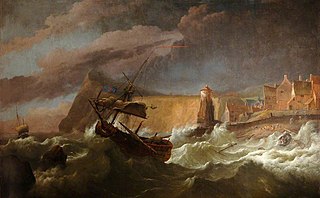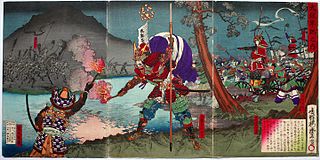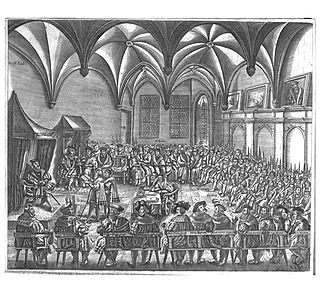Related Research Articles

1624 (MDCXXIV) was a leap year starting on Monday of the Gregorian calendar and a leap year starting on Thursday of the Julian calendar, the 1624th year of the Common Era (CE) and Anno Domini (AD) designations, the 624th year of the 2nd millennium, the 24th year of the 17th century, and the 5th year of the 1620s decade. As of the start of 1624, the Gregorian calendar was 10 days ahead of the Julian calendar, which remained in localized use until 1923.

1690 (MDCXC) was a common year starting on Sunday of the Gregorian calendar and a common year starting on Wednesday of the Julian calendar, the 1690th year of the Common Era (CE) and Anno Domini (AD) designations, the 690th year of the 2nd millennium, the 90th year of the 17th century, and the 1st year of the 1690s decade. As of the start of 1690, the Gregorian calendar was 10 days ahead of the Julian calendar, which remained in localized use until 1923.

1617 (MDCXVII) was a common year starting on Sunday of the Gregorian calendar and a common year starting on Wednesday of the Julian calendar, the 1617th year of the Common Era (CE) and Anno Domini (AD) designations, the 617th year of the 2nd millennium, the 17th year of the 17th century, and the 8th year of the 1610s decade. As of the start of 1617, the Gregorian calendar was 10 days ahead of the Julian calendar, which remained in localized use until 1923.

1691 (MDCXCI) was a common year starting on Monday of the Gregorian calendar and a common year starting on Thursday of the Julian calendar, the 1691st year of the Common Era (CE) and Anno Domini (AD) designations, the 691st year of the 2nd millennium, the 91st year of the 17th century, and the 2nd year of the 1690s decade. As of the start of 1691, the Gregorian calendar was 10 days ahead of the Julian calendar, which remained in localized use until 1923.

1615 (MDCXV) was a common year starting on Thursday of the Gregorian calendar and a common year starting on Sunday of the Julian calendar, the 1615th year of the Common Era (CE) and Anno Domini (AD) designations, the 615th year of the 2nd millennium, the 15th year of the 17th century, and the 6th year of the 1610s decade. As of the start of 1615, the Gregorian calendar was 10 days ahead of the Julian calendar, which remained in localized use until 1923.

1616 (MDCXVI) was a leap year starting on Friday of the Gregorian calendar and a leap year starting on Monday of the Julian calendar, the 1616th year of the Common Era (CE) and Anno Domini (AD) designations, the 616th year of the 2nd millennium, the 16th year of the 17th century, and the 7th year of the 1610s decade. As of the start of 1616, the Gregorian calendar was 10 days ahead of the Julian calendar, which remained in localized use until 1923.

Year 1555 (MDLV) was a common year starting on Tuesday of the Julian calendar.

1580 (MDLXXX) was a leap year starting on Friday of the Julian calendar, the 1580th year of the Common Era (CE) and Anno Domini (AD) designations, the 580th year of the 2nd millennium, the 80th year of the 16th century, and the 1st year of the 1580s decade. As of the start of 1580, the Gregorian calendar was 10 days ahead of the Julian calendar, which was the dominant calendar of the time.
The year 1615 in science and technology involved some significant events.
Richard Eden was an English alchemist and translator. His translations of the geographical works of other writers helped to foster enthusiasm for overseas exploration in Tudor England.
The decade of the 1530s in music involved some significant events, publications, compositions, births, and deaths.

Emery Molyneux was an English Elizabethan maker of globes, mathematical instruments and ordnance. His terrestrial and celestial globes, first published in 1592, were the first to be made in England and the first to be made by an Englishman.

Edward Wright was an English mathematician and cartographer noted for his book Certaine Errors in Navigation, which for the first time explained the mathematical basis of the Mercator projection by building on the works of Pedro Nunes, and set out a reference table giving the linear scale multiplication factor as a function of latitude, calculated for each minute of arc up to a latitude of 75°. This was in fact a table of values of the integral of the secant function, and was the essential step needed to make practical both the making and the navigational use of Mercator charts.

Robert Hues was an English mathematician and geographer. He attended St. Mary Hall at Oxford, and graduated in 1578. Hues became interested in geography and mathematics, and studied navigation at a school set up by Walter Raleigh. During a trip to Newfoundland, he made observations which caused him to doubt the accepted published values for variations of the compass. Between 1586 and 1588, Hues travelled with Thomas Cavendish on a circumnavigation of the globe, performing astronomical observations and taking the latitudes of places they visited. Beginning in August 1591, Hues and Cavendish again set out on another circumnavigation of the globe. During the voyage, Hues made astronomical observations in the South Atlantic, and continued his observations of the variation of the compass at various latitudes and at the Equator. Cavendish died on the journey in 1592, and Hues returned to England the following year.

Martín Cortés de Albacar (1510–1582) was a Spanish cosmographer. In 1551 he published the standard navigational textbook Arte de navegar. A decade later (1561), Arte de navegar became the earliest known English navigation manual up to date with all of the strategies used at the time.
The year 1545 in science and technology involved some significant events.
The year 1578 in science and technology included a number of events, some of which are listed here.
The year 1554 CE in science and technology included a number of events, some of which are listed here.
The year 1555 CE in science and technology included a number of events, some of which are listed here.

Michiel Coignet was a Flemish polymath who made significant contributions to various disciplines including cosmography, mathematics, navigation and cartography. He also built new and improved scientific instruments and made military engineering designs.
References
- ↑ Hadfield, Andrew (2004). "Eden, Richard (c.1520–1576)". Oxford Dictionary of National Biography . Oxford University Press. doi:10.1093/ref:odnb/8454 . Retrieved 2011-12-12.(subscription or UK public library membership required)
- ↑ Grun, Bernard (1991). The Timetables of History (3rd ed.). New York: Simon & Schuster. p. 247. ISBN 0-671-74919-6.